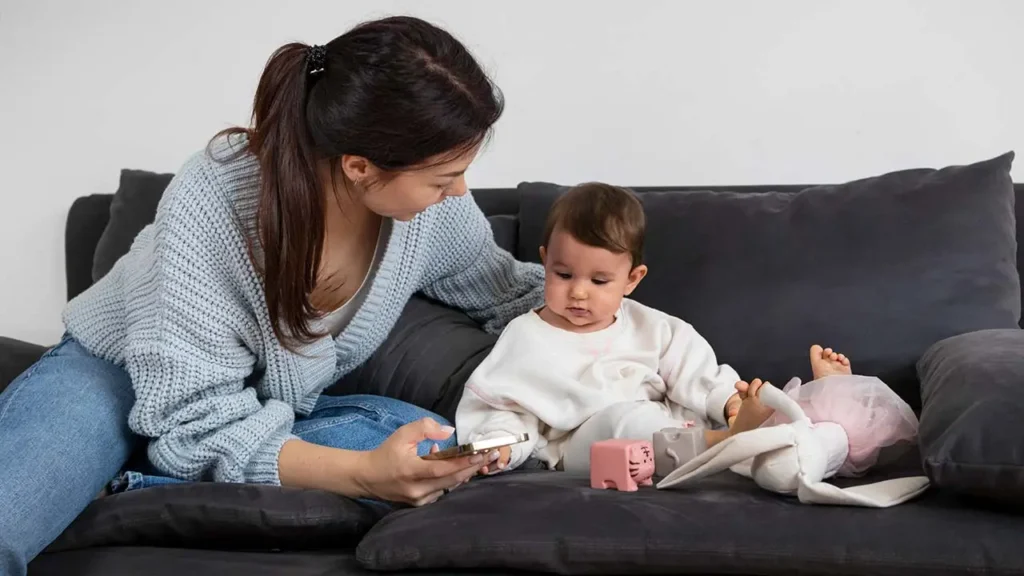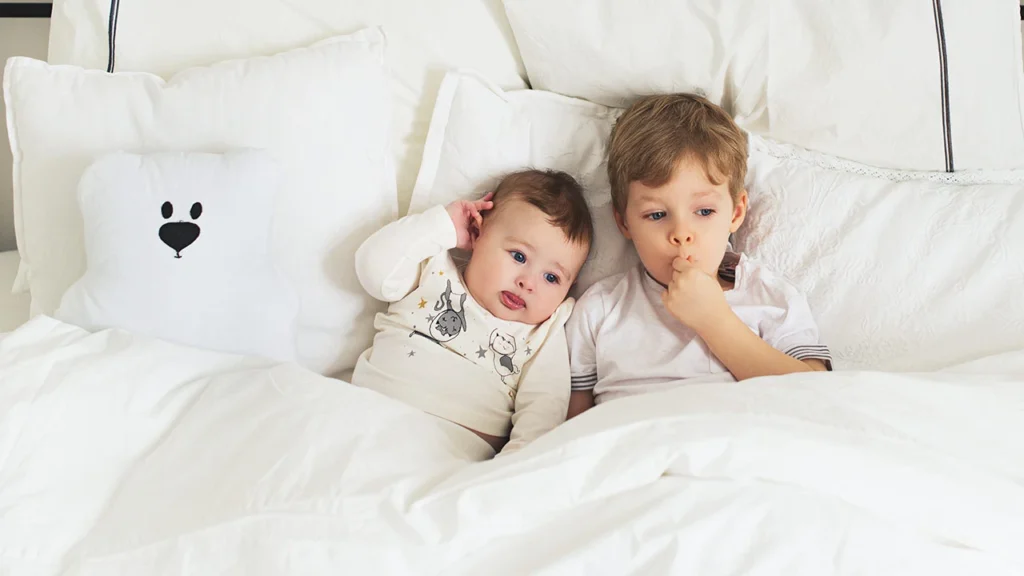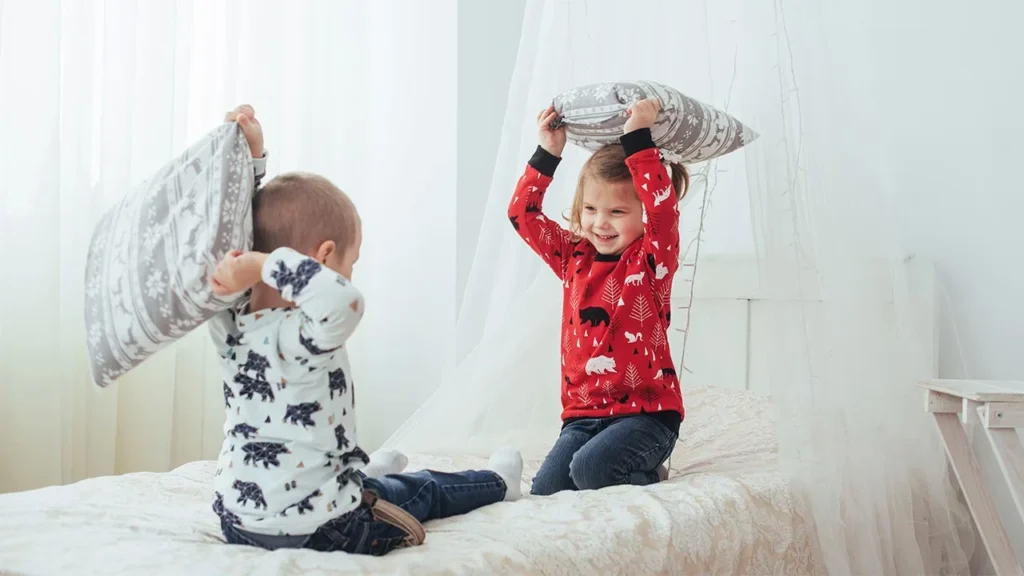When our second baby arrived, the house felt even smaller than it already was. Two bedrooms, that’s all we had. Keeping a newborn and a 4-year-old separate was not really an option. Some thought we were nuts putting them in one room, but sometimes you got to do what you got to do. If you’re facing similar parenting challenges and need inspiration, follow my advice. There are plenty of creative boy toddler and baby sharing room ideas to explore.
Making Room for Two
During the first few months, the baby stayed in our bedroom, snug in a pack-and-play, pushed as far from us as possible. Not that it was far—our room wasn’t exactly spacious. We got by with a sound machine (we tried the Hatch Rest Machine) and blackout curtains (we picked NICETOWN Blackout curtains) to help with sleep. It wasn’t perfect, but we managed.
At 12 weeks old and weighing in at 12 pounds, it was time. No more swaddle. No more sleeping in our room. We’d set up a crib in the shared space, which they now both called home. A dual-firmness crib mattress saved the day—firm for the baby, softer for when he grew older.
We gave them the bigger bedroom to make space for a twin bed and crib. Nightlights were banished, and sound machines hummed softly on both sides of the room. It wasn’t a cozy Pinterest scene, but it worked.

Transitioning the Baby
For three nights, the baby slept alone in the new room to get used to it. Room sharing with toddler siblings can feel daunting, but clear boundaries and gradual transitions help. Our 4-year-old camped out in our room on a mattress. By night four, we had a “big sister chat” about the rules of room-sharing. Her excitement was contagious—it felt like she’d been handed a big responsibility.
When Can My Toddler and Baby Start Sharing a Room?
There’s no one-size-fits-all answer to when siblings should start sharing a room. We aimed for when sleep schedules stabilized. Baby sharing room with toddler arrangements often depends on developmental stages. The American Academy of Pediatrics (AAP) recommends that babies should continue to room-share with their parents until at least 6 months of age, and ideally for the first year, to reduce the risk of Sudden Infant Death Syndrome (SIDS).
Avoiding developmental hurdles, like the 9-month sleep regression or toddler separation anxiety, made all the difference for us.
Setting Up a Shared Space

1. Layout First
Organizing the room became an art form. Sleeping and playing areas were clearly defined. For example, shared kid’s room ideas often emphasize functional layouts and clear zones. We used rugs to carve out zones and placed beds apart to minimize interruptions. The idea of curtains or dividers for privacy floated in our minds but wasn’t doable just yet.
2. Style Can Be Simple
The decor was about balance—soft, neutral colors with a few fun touches. Wall decals added charm without clutter. This is especially important for those tackling baby boy and girl room ideas where style needs to suit both siblings. Personalized bedding for both made it feel like each had their own little world.
3. Storage Wars
With kids, the mess is real. We fought back with under-bed bins and shelves mounted on the walls. Dual-purpose furniture—like toy chests that double as seating—was a lifesaver.
4. Safety Above All
Anchoring heavy furniture became my mantra. We placed the crib away from windows and cords. Babyproofing wasn’t a task; it was a lifestyle.
5. Fostering Bonds While Respecting Space
We found ways to make the room theirs—together. A small corner for each child’s toys kept conflicts at bay. Dividers weren’t just practical; they were a peacekeeper.
Small-Space Survival
In tight quarters, multi-functional furniture became essential. Maximizing space is necessary if you’re working parentsg with a small toddler and baby room. Wall-mounted lights opened up floors, and mirrors worked wonders to make the room feel bigger. It wasn’t glamorous, but it was efficient.
What I Learned Along the Way?

1. Sleep Independence is Key
Having two independent sleepers was a blessing. The fewer wake-ups, the happier everyone was. To be a good mother, I had to stay adaptable and think creatively about their needs.
2. One Bedtime Routine, Two Kids
A single bedtime routine streamlined the process. Prepping them both for bed at once saved energy. I often found myself thinking about how to become a better mom by promoting both connection and independence. One-on-one time with the older one, while the baby was settled, was our little secret weapon.
3. Stagger Bedtimes
The baby went down first. The sister followed after her stories. Less chatter, more sleep—it worked like a charm.
4. Communicate with the Toddler
Explaining the plan to my toddler made all the difference. With a strong-willed toddler, communication and consistency are key. Setting expectations ahead of time was a game-changer.
5. Keep Them Separate at Night
Spacing out the crib and the bed helped avoid disturbances. It wasn’t a perfect science, but it helped.
6. White Noise Saves the Day
A sound machine was a must. Early risers and noisy siblings are no match for the hum of white noise.
7. Blackout Curtains Are a Lifesaver
Dark mornings meant fewer early wake-ups. Enough said.
8. Teach Time Awareness
An OK-to-wake clock helped big sister understand when it was okay to get out of bed. The LittleHippo Mella Ready worked best for our kid.
9. Childproof Like a Pro
Furniture bolted, outlets covered, sharp corners cushioned. Every detail mattered.
Lower Expectations
Let’s be real—some nights were chaos. Tantrums, delays, interruptions—they happened. We rolled with it.
A Few Shared Room Favorites

1. Big & Little Siblings Shared Room
Shared rooms for siblings don’t need to be perfectly matched. Honestly, I’d say it’s better when they’re not. A toddler doesn’t have to move to a bigger bed before you’re ready just because it seems cohesive. See! Keeping furniture in similar colors and designs is enough; matching is overrated.
2. Back-to-Back Kid Bed Idea for Shared Room
What if beds didn’t face the same way? Putting them back-to-back can be both practical and stylish. Elementary-age kids might appreciate this, too. It creates a cozy spot for them to read quietly or drift off to sleep. Built-ins are genius for adding storage while letting kids feel like the space is truly theirs.
3. Pink & Blue Boy and Girl Shared Room
Shared kid’s room ideas come in all forms, and mixing practical designs with personal touches makes a big difference. Think boy-girl rooms are tricky? They’re not! Maybe she loves princesses, and he’s all about dinosaurs. That’s fine. You can blend their styles seamlessly. Boy and girl sibling room ideas thrive when individuality is respected. Scale furniture right, paint walls neutral, and mirror their favorite colors on each side. The result? A room that’s shared but also totally unique for both of them.
In the end, sharing a room became less about space and more about connection. It wasn’t perfect, but it taught us to adapt, to improvise, and to create a home where love came first—even in tight quarters.



